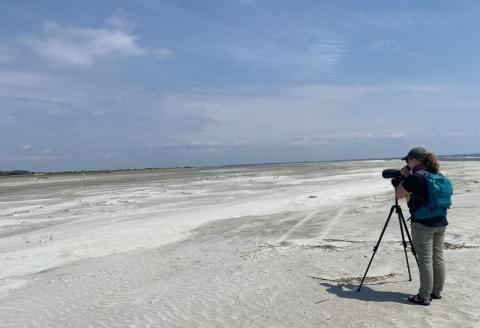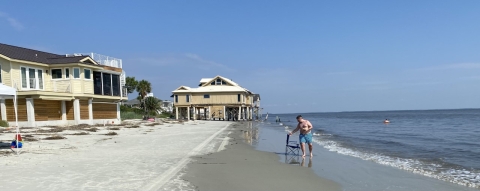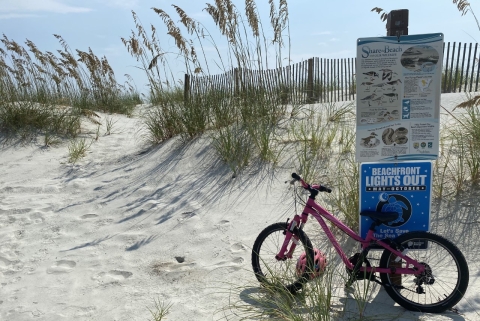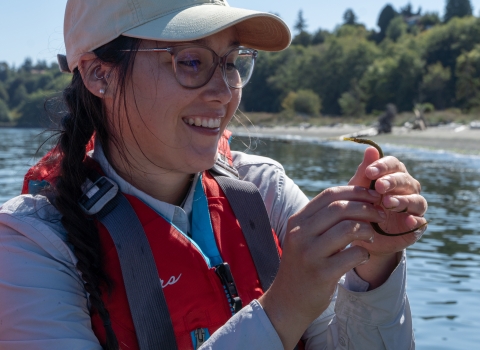Beaufort, South Carolina – All seems idyllic on Harbor Island with pastel-colored homes edging the dunes and beachgoers marveling at the army of seabirds and shorebirds on a nearby sandbar. Even the alligator ambling along the sidewalk adds to the tropical feel of Lowcountry living.
Looks, though, deceive, especially if you’re one of the rare piping plovers running out of beachfront room to roost. Climate change and its sinister handmaiden – sea level rise – threaten the migratory birds’ habitat. And the beaches of South Carolina, more so than the sandy shores of New York, Massachusetts, Michigan and beyond where the plovers breed, sit in the crosshairs of an increasingly hot, and angry, Mother Nature.
Most plovers, though, spend more time along the Atlantic beaches of the Carolinas, Georgia, and Florida than anywhere else in the United States. And, overall, they’re in relatively better shape along the Atlantic coast, with a federal designation as a “threatened” species, as opposed to their more dire designation as an “endangered” species across the Great Lakes region.
Yet the twiggy, melodic, sand-colored birds of the South are generally not recovering as well as they do up north. The Audubon Society predicts that plovers will lose 30 percent of their non-breeding range -- i.e., the Southeastern coastline – by 2080. “Climatic suitability,” or the lack thereof, will push the birds further north during the fall and winter seasons, Audubon says.
And the South Atlantic Bight, the shallow, curving coastline between Cape Hatteras, North Carolina and Cape Canaveral, Florida, will experience a “substantial increase” in erosion by 2030 due to sea level rise. While beaches naturally migrate, and provide new habitat for plovers, their movement increasingly bumps up against hard, immovable structures like beach homes and parking lots.
Melissa Chaplin, a beach biologist with the U.S. Fish and Wildlife Service in South Carolina, helped research a study published in 2018 that shows plovers fare considerably worse – and are more likely to die – in areas disturbed by the hand of man.
“There is less available habitat and the habitat they have is already disturbed,” Chaplin said during a recent stroll along Harbor Island. “And climate change climate change
Climate change includes both global warming driven by human-induced emissions of greenhouse gases and the resulting large-scale shifts in weather patterns. Though there have been previous periods of climatic change, since the mid-20th century humans have had an unprecedented impact on Earth's climate system and caused change on a global scale.
Learn more about climate change just exacerbates the threats they face from storms, infrastructure, and rising seas.”
Climate change crosshairs
Chaplin was prowling the beaches 25 miles below Charleston in search of plovers. The birds had recently begun returning from breeding grounds up north and Chaplin, with binoculars, spotting scope and GPS at the ready, set about counting them. Plovers are renowned for their “site fidelity,” or allegiance to certain beaches or barrier islands. They’ll return to the same sparsely vegetated spot each winter to get their fill of worms, larvae, and crustaceans. Harbor Island, and Hunting Island State Park across the Johnson Creek inlet, are prime bird-watching zones for Chaplin. She was not disappointed.
“Awesome. I’ve got 44 piping plovers today,” she said while observing a large flock of plovers (piping, Wilson’s, semipalmated), terns (royal, black, least), sanderlings, and assorted gulls. “At least five are from the Great Lakes. There’s a New York bird. And there’s a Canadian bird. The Canadians will be so excited. This is great.”
Chaplin zeroed in on the colorful bands on some of the plovers’ legs to determine where the birds migrated from. Orange-flagged birds came from the Great Lakes. Canadian birds sported white or black bands. Most birds, though, hail from up the Atlantic coast. The 2022 wintering season was off to a good start. It had better.
Of the three piping plover populations -- Atlantic Coast, Northern Great Plains, and Great Lakes – the easternmost birds are most plentiful. Fish and Wildlife and other conservation groups peg the Atlantic population at more than 4,000 mature, or breeding, individuals. In all, roughly 8,000 mature birds fly the skies from Canada to the Caribbean. Their numbers, though stabilizing overall, have dwindled significantly the last half century due largely to development along oceans and lakes. Climate change will only make matters worse.
South Carolina sits in the crosshairs of the warming world. With nearly 3,000 miles of tidal coastline – along the barrier islands, marshes, and sinewy streams that feed the Atlantic – the Palmetto State suffers the brunt of sea level rise. The waters off the S.C. coast have risen 10 inches since 1950 and fuel flooding up and down the coast. Charleston, for example, experienced, on average, two days of tidal flooding per year during the 1970s, according to the National Oceanic and Atmospheric Administration. By mid-century, it’s expecting 180 days of flooding. (They don’t call it the Lowcountry – average elevation of nearby Beaufort: 10 feet above sea level – for nothing.) The Atlantic is now rising an inch every two years.
Warmer weather also supercharges storms and inundates coastal communities. Hotter temps cause the Atlantic to evaporate which shoots moisture into the sky and over land worsening hurricanes, downpours, and flooding.
Evidence of the coast’s losing battle against Mother Nature abounds. Boneyard forests, where dead oaks have succumbed to rising, salty waters, are visible from Hunting Island. Half of the state park’s camp sites have gone under due to sea level rise, flooding, and storms. Groundwater levels under the plovers’ winter roosts continue to climb; Chaplin says she frequently hits water if she digs down two feet.
At high tide, only about 20 feet of Harbor Island beach remains. Yet there is no beach in the middle of the island when the tide comes fully in. A handful of homes have succumbed to the rising seas and storms since Hurricane Matthew roared by in 2016. Today, water encircles a half-dozen houses that are abandoned, condemned, or wobbling on concrete pilings. The wrack line abuts the wall of another, still-inhabited dwelling. One big storm and a couple more houses will tumble into the sea.
“So much stress”
Harbor Island sits near the middle of the South Atlantic Bight, the long, gradual bend in the coastline that, from space, looks like a large bay. More than 2,000 kilometers of the bight, or 43 percent, is projected to suffer serious erosion by 2030, according to a recent study in the Journal of Wildlife Management.
It gets worse for the piping plover: two-thirds of its most popular winter habitat will get smacked by sea level rise.
“The biggest impact from climate change, so far, is on the birds’ habitats,” Chaplin said. “There will always be a beach; these islands are always moving and they roll back on each other. But there’s very limited availability for the coast to move now. Half of South Carolina’s islands are already developed. It definitely further limits plovers’ population.”
Bigger storms fueled by warmer air and ocean temperatures push waves higher up the beach and over the dunes, a phenomenon known as overwash. That’s not too much of a problem for plovers in Virginia, New Jersey, and other coastlines up north with their back bays and room for beaches to grow. In South Carolina, though, beaches migrate smack dab into million-dollar homes, roads, and parking lots.
Chaplin and colleagues reported in 2018 that piping plovers “in disturbed sites” weighed seven percent less than those in less disturbed sites. And the birds, overall, were more likely to die. The plovers average life expectancy: 5 years.
“But the birds we banded in South Carolina disappeared within two or three years,” said Chaplin, who has been studying plovers since 2005. “The habitat that’s already disturbed probably ensures an early exit for them. And the conditions are getting worse. They’re under so much stress they may be aging quicker than before.”
Chaplin, though, plugs along doing what she can to save plovers. Signs along Harbor and Hunting islands, for example, warn beachcombers to avoid the birds’ foraging grounds and to keep dogs on leashes. With winter migration in full force, Chaplin hopes the plovers will fill these sandy flats between the dunes and the blue-green sea. But she’s realistic.
“It's really unpredictable and so concerning that these birds are already not doing well at these sites and they’ve been thrown another curve ball,” she said as the sun bore down on a fully crested tide. “Really any kind of beach nesting bird is in a lot of trouble already. If we can’t figure out how to deal with the problems they’re facing now how are they going to deal with climate change in the future?”







